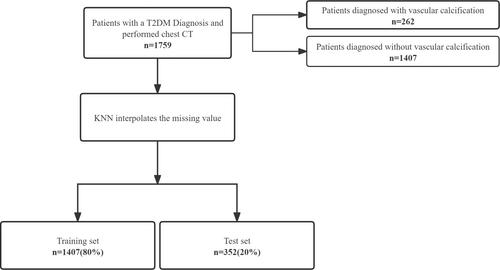A machine learning approach to predicting vascular calcification risk of type 2 diabetes: A retrospective study
Abstract
Background
Recently, patients with type 2 diabetes mellitus (T2DM) have experienced a higher incidence and severer degree of vascular calcification (VC), which leads to an increase in the incidence and mortality of vascular complications in patients with T2DM.
Hypothesis
To construct and validate prediction models for the risk of VC in patients with T2DM.
Methods
Twenty-three baseline demographic and clinical characteristics were extracted from the electronic medical record system. Ten clinical features were screened with least absolute shrinkage and selection operator method and were used to develop prediction models based on eight machine learning (ML) algorithms (k-nearest neighbor [k-NN], light gradient boosting machine, logistic regression [LR], multilayer perception [(MLP], Naive Bayes [NB], random forest [RF], support vector machine [SVM], XGBoost [XGB]). Model performance was evaluated using the area under the receiver operating characteristic curve (AUC), accuracy, and precision.
Results
A total of 1407 and 352 patients were retrospectively collected in the training and test sets, respectively. Among the eight models, the AUC value in the NB model was higher than the other models (NB: 0.753, LGB: 0.719, LR: 0.749, MLP: 0.715, RF: 0.722, SVM: 0.689, XGB:0.707, p < .05 for all). The k-NN model achieved the highest sensitivity of 0.75 (95% confidence interval [CI]: 0.633–0.857), the MLP model achieved the highest accuracy of 0.81 (95% CI: 0.767–0.852) and specificity of 0.875 (95% CI: 0.836–0.912).
Conclusions
This study developed a predictive model of VC based on ML and clinical features in type 2 diabetic patients. The NB model is a tool with potential to facilitate clinicians in identifying VC in high-risk patients.


 求助内容:
求助内容: 应助结果提醒方式:
应助结果提醒方式:


